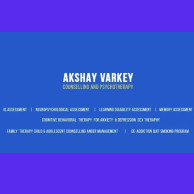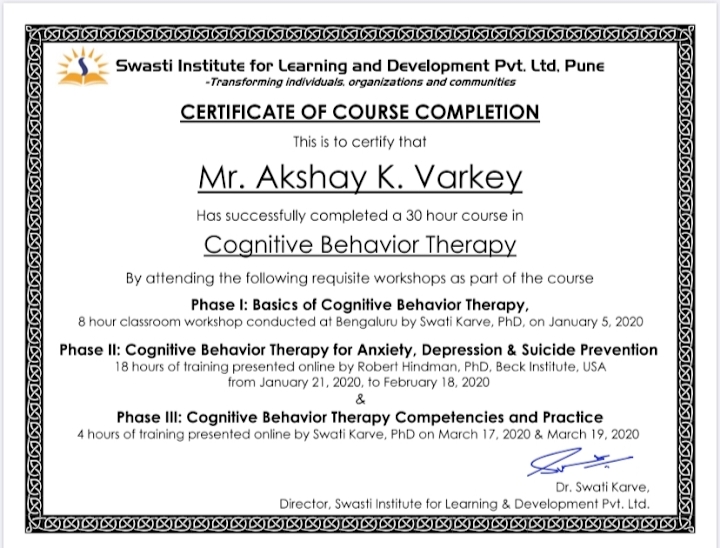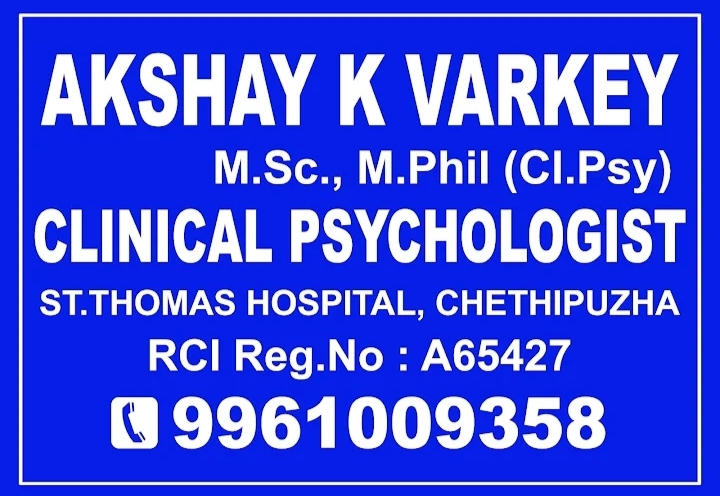Top 10 Family Therapy in Kottayam
Family is the cornerstone of emotional support, identity, and personal development. However, even the most loving families face periods of conflict, miscommunication, or stress that can impact harmony and mental health. That’s where family therapy plays a crucial role — helping families navigate challenges, improve communication, and rebuild healthy emotional bonds.
In a culturally rich and community-oriented district like Kottayam, the demand for family therapy is on the rise. With growing awareness about mental health and emotional well-being, many families are turning to professional therapists to address interpersonal issues, parenting conflicts, and mental health concerns within the family system.
This article explores the scope of family therapy in Kottayam, what it involves, its availability, and what customers commonly expect when seeking these services.
- Akshay Varkey Clinical Psychologist
SMRA 15 Valyaveedu, Muruga Nagar Road,
Near Sree Subrahmanya Swami Temple, Perunna, Changanassery,
Kottayam, 686102 - Mind Care Psychological Services
Near Kanjikuzhy Bus Stop,
Kanjikuzhy,
Kottayam, Kerala 686004 - Santhwana Institute of Counselling & Psychotherapy
Caritas Junction,
Thellakom P.O.,
Kottayam, Kerala 686630 - Dr. Preethi R – Clinical Psychologist
KIMSHEALTH Hospital,
Old MC Road, Near Collectorate,
Kottayam, Kerala 686002 - Anugraha Mental Health Centre
Baker Junction,
Kottayam, Kerala 686001 - Navajeevan Psychological Services
Opposite BCM College,
Kottayam, Kerala 686001 - Caritas Mental Health Centre
Caritas Hospital Campus,
Thellakom,
Kottayam, Kerala 686630 - Mindscape Psychology Clinic
Near District Court,
Nagampadom,
Kottayam, Kerala 686002 - Dr. Mathew Thomas – Consultant Psychologist
Matha Hospital,
Thellakom,
Kottayam, Kerala 686630 - Prathyasha Counselling Centre
Near Kalathipady Junction,
Kanjikuzhy,
Kottayam, Kerala 686004
Comprehensive Guide to Physiotherapy in Kottayam
Physiotherapy, also known as physical therapy, is a healthcare profession that helps individuals recover from injuries, surgeries, and medical conditions through physical exercises, manual therapy, and other rehabilitative techniques. The primary goal of physiotherapy is to restore movement and function, reduce pain, and prevent future injuries. This holistic approach can be applied to a wide range of conditions, including cardiac, post-surgical, musculoskeletal, and neurological issues such as strokes.
In this detailed guide, we will explore various types of physiotherapy rehabilitation programs, including Cardiac Rehabilitation Centers, Post-Surgery Rehabilitation, Musculoskeletal Rehabilitation, and Stroke Rehabilitation. Each rehabilitation program is designed to address specific health challenges and needs, providing patients with tailored care and support.
Cardiac Rehabilitation Centers in Kottayam
Cardiac rehabilitation is a specialized form of
physiotherapy aimed at helping individuals recover from heart-related issues
such as heart attacks, heart surgeries, and other cardiovascular conditions.
The program focuses on improving cardiovascular health, strength, and overall
well-being through a combination of exercises, education, and lifestyle
changes.
Key Components of Cardiac Rehabilitation:
- Exercise
training: Cardiovascular exercises like
walking, cycling, and resistance training help strengthen the heart and
improve endurance. A physiotherapist designs a personalized exercise plan
based on the patient's fitness level and health condition.
- Education
and counseling: Patients receive information on
managing their heart condition, including healthy eating, stress
management, and smoking cessation.
- Risk
factor management: The program helps patients
control risk factors such as high blood pressure, cholesterol, and
diabetes through lifestyle modifications and medication.
Benefits of Cardiac Rehabilitation:
- Improved
heart health and function
- Reduced
risk of future heart issues
- Enhanced
quality of life and physical stamina
- Emotional
support to cope with the mental challenges of heart conditions
Stroke Rehabilitation
Stroke rehabilitation is a critical part of recovery
for individuals who have experienced a stroke. Physiotherapy plays a vital role
in helping stroke survivors regain physical function, improve mobility, and
enhance their quality of life. The rehabilitation process focuses on restoring
independence and maximizing the patient's ability to perform daily activities.
Key Components of Stroke Rehabilitation:
- Gait
training: Stroke patients often experience
difficulty walking due to muscle weakness or paralysis. Physiotherapists
work on improving balance, coordination, and walking ability through
targeted exercises and gait retraining.
- Strengthening
exercises: Exercises are designed to
strengthen the muscles that may have been weakened or affected by the
stroke, particularly in the arms and legs.
- Range
of motion exercises: These exercises help maintain
joint flexibility and prevent stiffness, especially in the affected limbs.
- Balance
and coordination training: Stroke survivors
often have impaired balance and coordination, making it difficult to move
safely. Physiotherapy helps improve these skills, reducing the risk of
falls.
- Assistive
devices: Patients may need assistive devices
such as walkers, canes, or braces to improve mobility and independence.
- Benefits of Stroke Rehabilitation:
- Improved
mobility and ability to perform daily tasks
- Enhanced
muscle strength and coordination
- Reduced
risk of falls and further complications
- Better
quality of life and increased independence
Post-Surgery Rehabilitation in Kottayam
Post-surgery rehabilitation is a vital part of the
recovery process after any major surgical procedure. Physiotherapy can help
patients regain mobility, reduce pain, and rebuild strength. It is commonly
recommended for patients recovering from orthopedic surgeries (such as knee or
hip replacements), abdominal surgeries, and even cardiac surgeries.
Key Components of Post-Surgery
Rehabilitation:
- Pain
management: Physiotherapists use techniques like
ice therapy, heat therapy, and electrical stimulation to reduce pain and
inflammation.
- Exercise
therapy: Targeted exercises help rebuild
strength, flexibility, and mobility in the affected area. These exercises
are customized according to the type of surgery and the patient's
progress.
- Scar
tissue management: Manual therapy techniques such
as massage can prevent excessive scar tissue buildup and improve the
healing process.
- Mobility
training: Patients may need assistance in
learning how to move safely, use crutches or other assistive devices, and
gradually return to normal activities.
- Benefits of Post-Surgery Rehabilitation:
- Faster
recovery and reduced risk of complications
- Improved
mobility and joint function
- Enhanced
strength and stamina
- Prevention
of secondary complications such as blood clots or muscle atrophy
Musculoskeletal Rehabilitation
Musculoskeletal rehabilitation focuses on treating
injuries and disorders affecting the muscles, bones, joints, and ligaments. It
is often recommended for conditions like arthritis, fractures, sports injuries,
and chronic pain conditions such as lower back pain or neck pain. Physiotherapy
can also address workplace injuries and repetitive strain injuries, helping
patients recover and return to their daily activities.
Key Components of Musculoskeletal
Rehabilitation:
- Manual
therapy: Techniques such as joint
mobilization, soft tissue massage, and stretching help improve flexibility
and reduce pain.
- Exercise
programs: Physiotherapists design exercise
routines to strengthen muscles, improve joint stability, and enhance
coordination. These exercises may include resistance training, stretching,
and aerobic activities.
- Posture
correction: Poor posture can contribute to
musculoskeletal pain. Physiotherapists work with patients to correct their
posture and prevent further injury.
- Education:
Patients learn how to manage their condition
through proper body mechanics, ergonomics, and self-care techniques.
- Benefits of Musculoskeletal
Rehabilitation:
- Relief
from pain and discomfort
- Improved
mobility and range of motion
- Enhanced
strength and muscle balance
- Prevention
of future injuries through education and corrective exercises
Frequently Asked Questions about Physiotherapy in Kottayam
1. What is the role of physiotherapy in
cardiac rehabilitation?
Answer: Physiotherapy plays a critical role in cardiac
rehabilitation by designing safe and effective exercise programs that improve
cardiovascular health. It helps strengthen the heart, improve stamina, and
reduce the risk of future heart problems. A physiotherapist also provides
education on managing risk factors such as diet, exercise, and stress.
2. How soon should I start physiotherapy
after surgery?
Answer: The timing of physiotherapy after surgery
depends on the type of surgery and the patient’s overall condition. In most
cases, rehabilitation can start as early as a few days after surgery, once the
patient is stable. Your doctor or surgeon will recommend the best time to begin
physiotherapy to ensure a smooth recovery.
3. What types of injuries can
musculoskeletal rehabilitation treat?
Answer: Musculoskeletal rehabilitation can treat a
wide range of conditions, including fractures, sprains, strains, dislocations,
arthritis, sports injuries, repetitive strain injuries, and chronic pain
conditions like back pain and neck pain. Physiotherapists use a combination of
manual therapy, exercises, and education to address these issues.
4. How long does stroke rehabilitation
take?
Answer: Stroke rehabilitation varies depending on the
severity of the stroke and the individual's recovery progress. While some
patients may regain significant function within a few months, others may
require ongoing therapy for several years. Early intervention and consistent
physiotherapy can greatly improve the chances of recovery.
5. Can physiotherapy help prevent future
injuries?
Answer: Yes, physiotherapy can help prevent future
injuries by improving strength, flexibility, and balance. Physiotherapists also
educate patients on proper body mechanics, posture, and ergonomic techniques,
reducing the likelihood of re-injury or developing new injuries.





